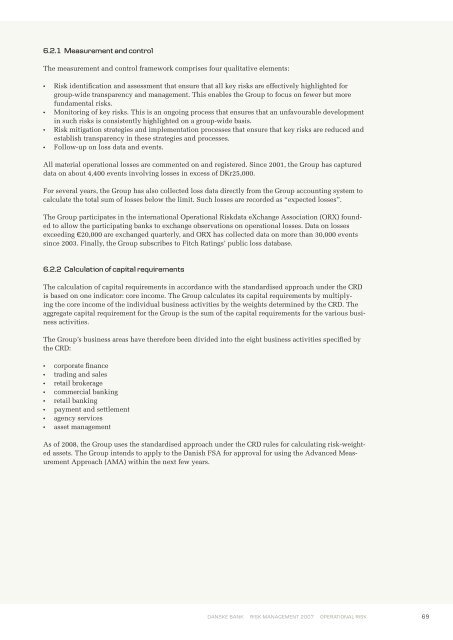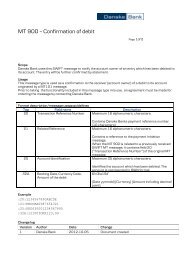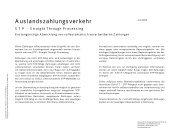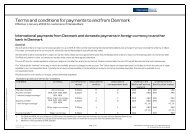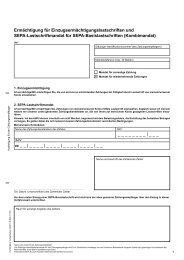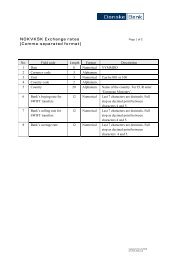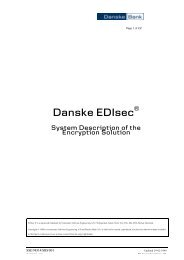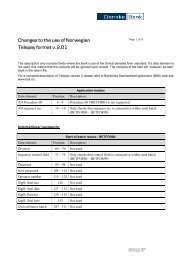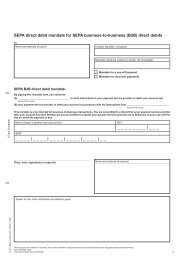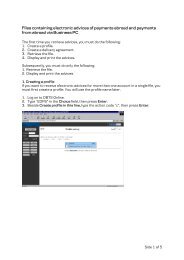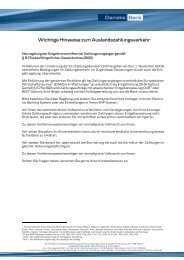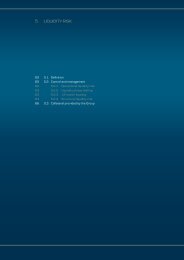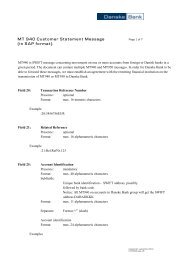6. OpEraTiONaL riSk - Danske Bank
6. OpEraTiONaL riSk - Danske Bank
6. OpEraTiONaL riSk - Danske Bank
You also want an ePaper? Increase the reach of your titles
YUMPU automatically turns print PDFs into web optimized ePapers that Google loves.
<strong>6.</strong>2.1 Measurement and control<br />
The measurement and control framework comprises four qualitative elements:<br />
• Risk identification and assessment that ensure that all key risks are effectively highlighted for<br />
group-wide transparency and management. This enables the Group to focus on fewer but more<br />
fundamental risks.<br />
• Monitoring of key risks. This is an ongoing process that ensures that an unfavourable development<br />
in such risks is consistently highlighted on a group-wide basis.<br />
• Risk mitigation strategies and implementation processes that ensure that key risks are reduced and<br />
establish transparency in these strategies and processes.<br />
• Follow-up on loss data and events.<br />
All material operational losses are commented on and registered. Since 2001, the Group has captured<br />
data on about 4,400 events involving losses in excess of DKr25,000.<br />
For several years, the Group has also collected loss data directly from the Group accounting system to<br />
calculate the total sum of losses below the limit. Such losses are recorded as “expected losses”.<br />
The Group participates in the international Operational Riskdata eXchange Association (ORX) founded<br />
to allow the participating banks to exchange observations on operational losses. Data on losses<br />
exceeding ¤20,000 are exchanged quarterly, and ORX has collected data on more than 30,000 events<br />
since 2003. Finally, the Group subscribes to Fitch Ratings’ public loss database.<br />
<strong>6.</strong>2.2 Calculation of capital requirements<br />
The calculation of capital requirements in accordance with the standardised approach under the CRD<br />
is based on one indicator: core income. The Group calculates its capital requirements by multiplying<br />
the core income of the individual business activities by the weights determined by the CRD. The<br />
aggregate capital requirement for the Group is the sum of the capital requirements for the various business<br />
activities.<br />
The Group’s business areas have therefore been divided into the eight business activities specified by<br />
the CRD:<br />
• corporate finance<br />
• trading and sales<br />
• retail brokerage<br />
• commercial banking<br />
• retail banking<br />
• payment and settlement<br />
• agency services<br />
• asset management<br />
As of 2008, the Group uses the standardised approach under the CRD rules for calculating risk-weighted<br />
assets. The Group intends to apply to the Danish FSA for approval for using the Advanced Measurement<br />
Approach (AMA) within the next few years.<br />
DANSKE BANK RISK MANAGEMENT 2007 OPERATIONAL RISK<br />
69


